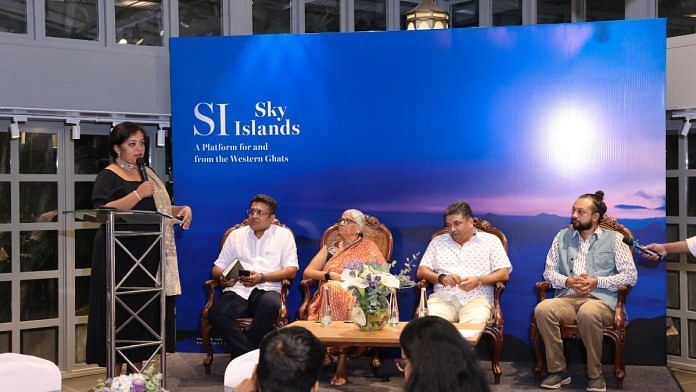Chennai: Sahaya Mary entered the Kodaikanal forest for the first time when she was only 10. She recalls seeing mushrooms, raspberries, blueberries and wild animals in Palani Hills. Today, the forest-gatherer is 65, the animals have disappeared and Kodaikanal is a giant traffic jam.
“There are no fruits in Kodai as before. And the place is full of buildings,” she said.
Mary’s 10-minute story was the microcosm of a larger discussion held at the Wild Garden Cafe in Chennai. The event, recently organised by The Kodai Chronicle Trust, featured prominent voices from Kodaikanal and beyond who spoke passionately about the Western Ghats’ rich biodiversity as well as the challenges it faces in the form of climate change, unregulated tourism and human-animal conflict.
The event—featuring reputed ecologists and politicians—also marked the pre-launch of Sky Islands, an online publication that’ll feature hyperlocal accounts from across the Western Ghats.
“At Sky Islands, we will continue to focus on hyperlocal stories while connecting to larger narratives. The model we have piloted with The Kodai Chronicle [magazine] has featured stories that are deeply rooted in their local context, mostly informed by those living there and writing these stories or by experts/specialists who spend time in the hills or have spent time there,” said Rajni George, founding editor of The Kodai Chronicle.
The stories speak for themselves. ‘A Slow Walk Through the Nilgiri Hills,’ an article that appeared in The Kodai Chronicle in February, details a traveller’s experience during a personalised tour in Ooty. But the article is not a travelogue. It’s about a local tour guide called Anne, the smells she grew up with in Ooty, and the cosiness of the place as a whole.
“We organised this event because we wanted to connect the mountains with supporters in Chennai and further afield, towards the launch of our new Western Ghats-wide platform and publication, Sky Islands,” said George. The English magazine will be published online every week, with plans to expand into Tamil and other regional languages. A print edition isn’t being considered yet but can be released once a year based on demand, added George.
Creating a local economy
Palanivel Thiaga Rajan, Tamil Nadu’s IT and digital services minister, said that some progress had been made in curbing tourism over dependency and creating livelihood in hill stations. Places like Ooty, for one, are moving away from tea plantations to cultivate organic high-value crops such as strawberry and cabbage, he added.
“As the IT Minister, I will say that I will try my best. As far as Ooty and all is concerned, there is a very relatively high level of education. So we want to try and set up some knowledge industries and the government can build some of these tech parks,” he said during the panel discussion on the civic issues in the Western Ghats.
One of India’s most popular tourist destinations, Kodaikanal continues to see an upsurge in visitors. According to the Tamil Nadu government’s 2018 Kodaikanal Master Plan, the foggy hill town, which only received over 12 lakh visitors in 2000, saw a footfall of 71 lakh tourists in 2017.
According to the Madurai Regional Office’s 2003 Land Use Survey data, about 75.7 per cent of Kodaikanal’s 2,145-hectare land mass is designated for reserve forests, prohibited areas, primary vegetative areas and agricultural activities. The remaining 24.30 per cent includes developed areas – industrial, commercial and residential.
Also read: ‘I Will Draw my Own Laxman Rekha’—Gogi Saroj Pal reimagines Indian myths free of male gaze
‘Too many people, Bungalows’
Salem Dharanidharan, state deputy secretary of the Dravida Munnetra Kazhagam (DMK) IT wing, said mountains, like cities, need sufficient professional urban planners.
“Until 2009, the country only produced 60 urban planners a year. According to the World Bank, we need about 3 lakh; we only have 5,000 urban planners. And we are talking about 8,000 cities and about 4 lakh villagers,” he said.
Talking about the increase in civic issues in Kodaikanal, author and environmentalist Zai Whitaker said that the town has seen many local protests that have, over time, yielded positive results.
Rampant plantation and landscape changes in hill towns like Kodaikanal, however, have damaged the Western Ghats’ delicate ecology. One of the victims is the Nilgiri pipit, a bird that was once abundant in the region but is now perilously close to going “locally extinct”. Failure to preserve the marshy montane shola grasslands where it nested caused its decline, said ecologists at the event.
“The challenges are simple. When we look at the data gathered over the years, we can see that a large part of the landscape in the shola habitat has changed a lot,” said VV Robin, associate professor at the Indian Institute of Science Education and Research (IISER) Tirupati and a bird ecologist.
More and more people are cutting down forested areas to set up homestays, causing wild animals to venture into human areas, said Smriti Lamech, a Kodaikanal resident. On top of that, there is “a severe traffic problem here in Kodaikanal,” she said, adding that it’s becoming increasingly difficult to even accomplish basic tasks like shopping or visiting the doctor.
Conducting a carrying capacity study of the town is now more important than ever, she told ThePrint.
“We need to work with the authorities to plan for better management of traffic and overcrowding; by calculating carrying capacity, as courts seem to be moving on addressing,” said George while also recommending an e-pass system to plan a regulated system for visiting the mountains.
“Now there is no rain and there are too many people and bungalows. Kodaikanal looks like Chennai,” Mary told ThePrint after the event.
(Edited by Zoya Bhatti)



